Economic Analysis and Optimal Control Strategy of Micro Gas-Turbine with Batteries and Water Tank: German Case Study
Abstract
:1. Introduction
- The system is running, and the demands are directly fulfilled with the energy produced;
- The system is running, but there is partial or no demand: the water tank and the batteries are loaded. If the batteries are full, electricity can be fed back into the grid;
- The system is not running, and the demands are fulfilled with the energy from the water tank and batteries. If the batteries are empty, electricity is provided from the grid;
- The system is not running, and there is no demand: nothing happens, apart from heat losses removing heat from the water tank.
- The present work proves mathematically if operating an MGT-based CHP system at partial-load is economically more profitable than at full-load;
- An algorithm to determine the most economical operative profile was developed and can be extended easily to other MGTs and countries as well;
- This work provides clear guidelines for battery and water tank sizing depending on building size, occupancy, and climate zone;
- This work constitutes the foundation of any lifetime prediction of MGT components, since it clearly defines the order and number or starts, stops, and loads, hence the working cycle.
- Real-world energy demands (building occupancy, day of the week, season, weather, geographical area) are considered instead of constant values;
- Batteries and thermal storage are examined together in the analysis (elsewhere often treated separately);
- The possibility to feed the excess electricity back into the net is considered in the price function;
- A finite price per day can be given for any operative profile, building size, day of the week, season, weather, or geographical area.
State-of-the-Art
2. Experimental Data and Machine Characterization
2.1. Steady State
2.2. Transient State, Start, and Cool-Down
3. Numerical Model
3.1. Performance Analysis
3.2. Energy Demand Profiles
3.2.1. Climate Zones
3.2.2. Day of the Week, Season, and Weather
3.3. Convective Losses of the Thermal Storage Tank
3.4. Optimization Process and Number of Iterations
4. Results and Discussion
4.1. Influence of Battery Size
4.2. Influence of Thermal Storage Size
4.3. Determination of the Optimal Operative Profiles
5. Conclusions
Author Contributions
Funding
Data Availability Statement
Acknowledgments
Conflicts of Interest
Abbreviations
| CHP | Combined Heat and Power |
| DLR | Deutsches Zentrum fuer Luft- und Raumfahrt |
| DWD | German Meteorological Service |
| LHV | Lower Heating Value |
| MFH | Multiple-Family House |
| MGT | Micro Gas Turbine |
| SFH | Single-Family House |
| SHW | Sanitary Hot Water |
| SP | Setting Point |
| SSX | Summer, Weekend Day, Neutral Weather |
| SWX | Summer, Working Day, Neutral Weather |
| TOT | Turbine Outlet Temperature |
| USB | Intermediate Season, Working Day, Cloudy |
| USH | Intermediate Season, Working Day, Sunny |
| UWB | Intermediate Season, Weekend Day, Cloudy |
| UWH | Intermediate Season, Weekend Day, Sunny |
| WSB | Winter, Weekend Day, Cloudy |
| WSH | Winter, Weekend Day, Sunny |
| WWB | Winter, Working Day, Cloudy |
| WWH | Winter, Working Day, Sunny |
References
- Beith, R. Small and Micro Combined Heat and Power (CHP) Systems; Woodhead Publishing Series in Energy; Woodhead Publishing Limited: Cambridge, UK, 2011. [Google Scholar]
- Ma, Z.; Knotzer, A.; Billanes, J.D.; Jørgensen, B.N. A literature review of energy flexibility in district heating with a survey of the stakeholders’ participation. Renew. Sustain. Energy Rev. 2020, 123, 109750. [Google Scholar] [CrossRef]
- González-Pino, I.; Pérez-Iribarren, E.; Campos-Celador, A.; Terés-Zubiaga, J. Analysis of the integration of micro-cogeneration units in space heating and domestic hot water plants. Energy 2020, 200, 117584. [Google Scholar] [CrossRef]
- Sayegh, M.; Danielewicz, J.; Nannou, T.; Miniewicz, M.; Jadwiszczak, P.; Piekarska, K.; Jouhara, H. Trends of European research and development in district heating technologies. Renew. Sustain. Energy Rev. 2017, 68, 1183–1192. [Google Scholar] [CrossRef] [Green Version]
- Reinders, A.; Verlinden, P.; Van Sark, W.; Freundlich, A. Photovoltaic Solar Energy: From Fundamentals to Applications; John Wiley & Sons: Hoboken, NJ, USA, 2017. [Google Scholar]
- Ebrahimi, M.; Keshavarz, A. 3-CCHP Evaluation Criteria. In Combined Cooling, Heating and Power; Ebrahimi, M., Keshavarz, A., Eds.; Elsevier: Boston, MA, USA, 2015; pp. 93–102. [Google Scholar] [CrossRef]
- Wang, X.; Palazoglu, A.; El-Farra, N.H. Operational optimization and demand response of hybrid renewable energy systems. Appl. Energy 2015, 143, 324–335. [Google Scholar] [CrossRef]
- Paepe, W.D.; Abraham, S.; Tsirikoglou, P.; Contino, F.; Parente, A.; Ghorbaniasl, G. Operational Optimization of a Typical micro Gas Turbine. Energy Procedia 2017, 142, 1653–1660. [Google Scholar] [CrossRef]
- Camporeale, S.M.; Fortunato, B.; Torresi, M.; Turi, F.; Pantaleo, A.M.; Pellerano, A. Part Load Performance and Operating Strategies of a Natural Gas—Biomass Dual Fueled Microturbine for Combined Heat and Power Generation. J. Eng. Gas Turbines Power 2015, 137, 121401. [Google Scholar] [CrossRef]
- Gimelli, A.; Sannino, R. A Micro Gas Turbine one-dimensional model: Approach description, calibration with a vector optimization methodology and validation. Appl. Therm. Eng. 2021, 188, 116644. [Google Scholar] [CrossRef]
- Kneiske, T.M.; Braun, M. Flexibility potentials of a combined use of heat storages and batteries in PV-CHP hybrid systems. Energy Procedia 2017, 135, 482–495. [Google Scholar] [CrossRef]
- Thu, K.; Saha, B.B.; Chua, K.J.; Bui, T.D. Thermodynamic analysis on the part-load performance of a microturbine system for micro/mini-CHP applications. Appl. Energy 2016, 178, 600–608. [Google Scholar] [CrossRef]
- Zhang, H.; Cai, J.; Fang, K.; Zhao, F.; Sutherland, J.W. Operational optimization of a grid-connected factory with onsite photovoltaic and battery storage systems. Appl. Energy 2017, 205, 1538–1547. [Google Scholar] [CrossRef]
- Gercek, C.; Reinders, A. Smart Appliances for Efficient Integration of Solar Energy: A Dutch Case Study of a Residential Smart Grid Pilot. Appl. Sci. 2019, 9, 581. [Google Scholar] [CrossRef] [Green Version]
- Ahout, W.; Hamilton, L. A Different Approach to Micro CHP, Final Report; Europe Commission H2020 Framework Programme. 2019, Volume 701006. Available online: https://cordis.europa.eu/project/id/701006/results/de (accessed on 11 May 2022).
- VDI 4655; Reference Load Profiles of Residential Buildings for Power, Heat and Domestic Hot Water as Well as Reference Generation Profiles for Photovoltaic Plants. Deutsche Institut für Normung e. V. (DIN): Berlin, Germany, 2019.
- Maj, M. Optimized Operation of the MTT EnerTwin in Non-Continuous or Part Load Operation. Master’s Thesis, Instituto Superior Técnico Lisbon, Lisbon, Portugal, 2017. [Google Scholar]
- Seliger-Ost, H.; Kutne, P.; Zanger, J.; Aigner, M. Experimental Investigation of the Impact of Biogas on a 3 kW Micro Gas Turbine FLOX®-based Combustor. In Turbo Expo: Power for Land, Sea, and Air; Volume 4B: Combustion, Fuels, and Emissions; American Society of Mechanical Engineers: New York, NY, USA, 2020. [Google Scholar] [CrossRef]
- Visser, W.P.J.; Shakariyants, S.; de Later, M.T.L.; Ayed, A.H.; Kusterer, K. Performance Optimization of a 3kW Microturbine for CHP Applications. In Manufacturing Materials and Metallurgy—Marine Microturbines and Small Turbomachinery—Supercritical CO2 Power Cycles; ASME International: New York, NY, USA, 2012; Volume 5, pp. 619–628. [Google Scholar] [CrossRef]
- Federal Network Agency. Annual Report for Electricity Prices, Federal Network Agency (Bundesnetzagentur). 2020. Available online: https://www.bundesnetzagentur.de/EN/General/Bundesnetzagentur/Publications/publications_node.html (accessed on 11 May 2022).
- DIN 18599; Energy Efficiency of Buildings—Calculation of the Net, Final and Primary Energy Demand for Heating, Cooling, Ventilation, Domestic Hot Water and Lighting—Part 1: General Balancing Procedures, Terms and Definitions, Zoning and Evaluation Of Energy Sources. Deutsche Institut für Normung e. V. (DIN): Berlin, Germany, 2018.
- DIN 4710; Meteorological Data for Technical Building Services Purposes—Degree Days. Deutsche Institut für Normung e. V. (DIN): Berlin, Germany, 2007.
- Pau, D.S.W.; Fleischmann, C.M.; Spearpoint, M.J.; Li, K.Y. Thermophysical properties of polyurethane foams and their melts. Fire Mater. 2013, 38, 433–450. [Google Scholar] [CrossRef]
- Mongird, K.; Viswanathan, V.V.; Balducci, P.J.; Alam, M.J.E.; Fotedar, V.; Koritarov, V.S.; Hadjerioua, B. Energy Storage Technology and Cost Characterization Report; US Department of Energies, Pacific Northwest National Laboratory (PNNL): Richland, WA, USA, 2019. [CrossRef]
- EASE (European Association for Energy Storage). Energy Storage Technologies; EASE (European Association for Energy Storage): Brussels, Belgium, 2016; Available online: https://ease-storage.eu/energy-storage/technologies/ (accessed on 11 May 2022).
- Financing for Mini-CHP Systems up to 20 kWel; Federal Office of Economics and Export Control (Bundesamt für Wirtschaft und Ausfuhrkontrolle): Eschborn, Germany, 2020; Available online: https://www.bafa.de/DE/Energie/Energieeffizienz/Kraft_Waerme_Kopplung/Mini_KWK/mini_kwk_node.html (accessed on 11 May 2022).
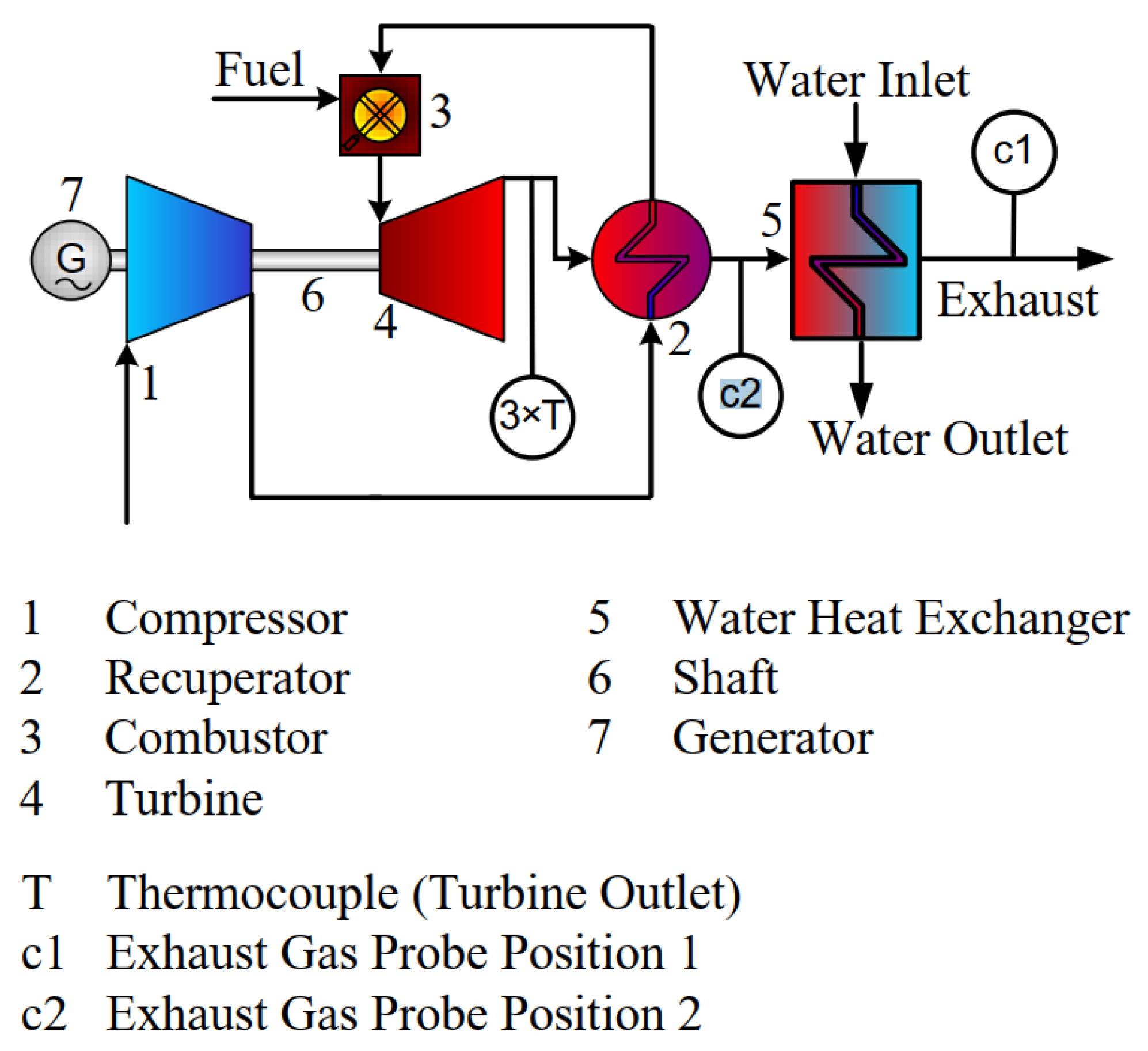



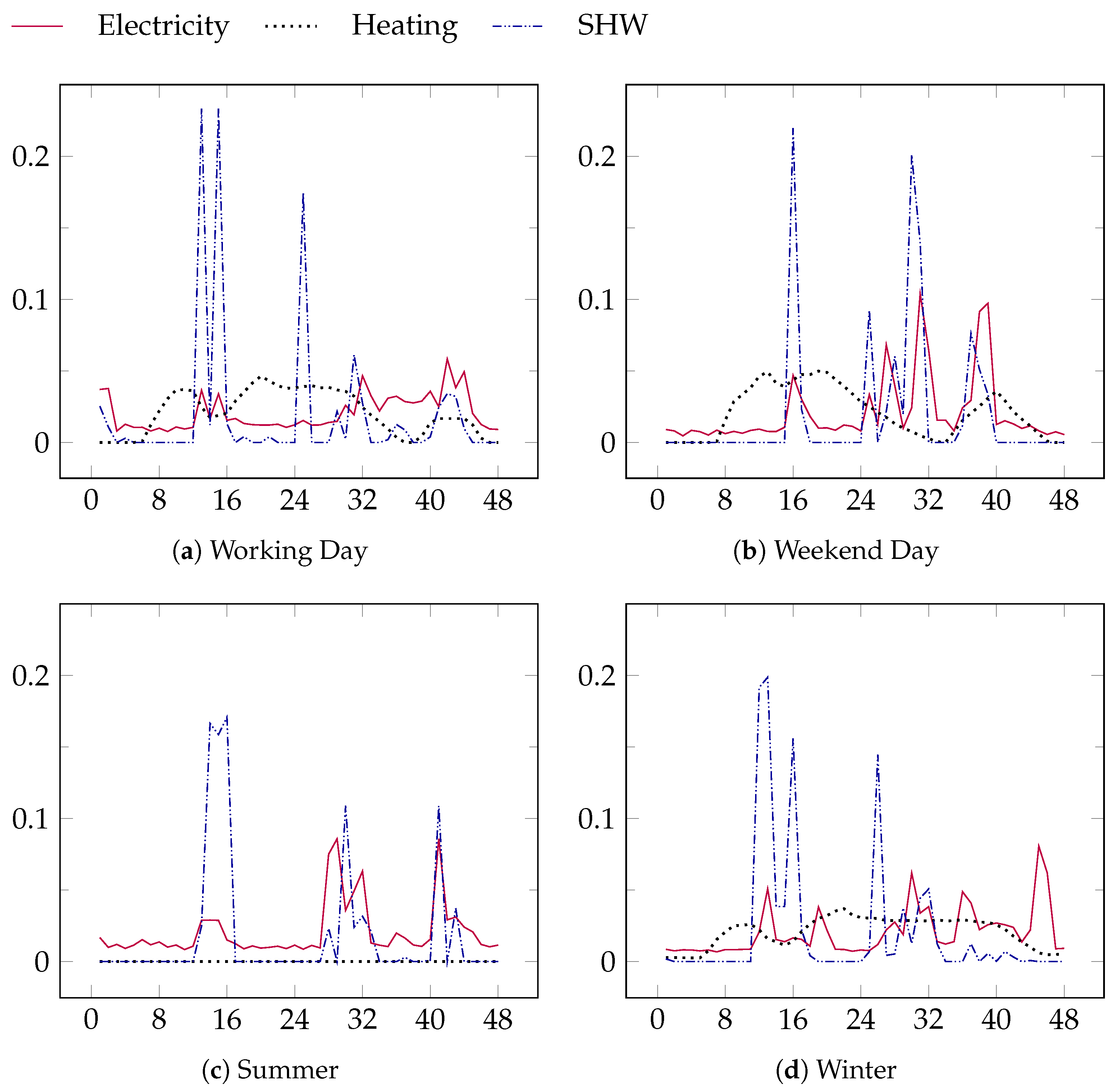
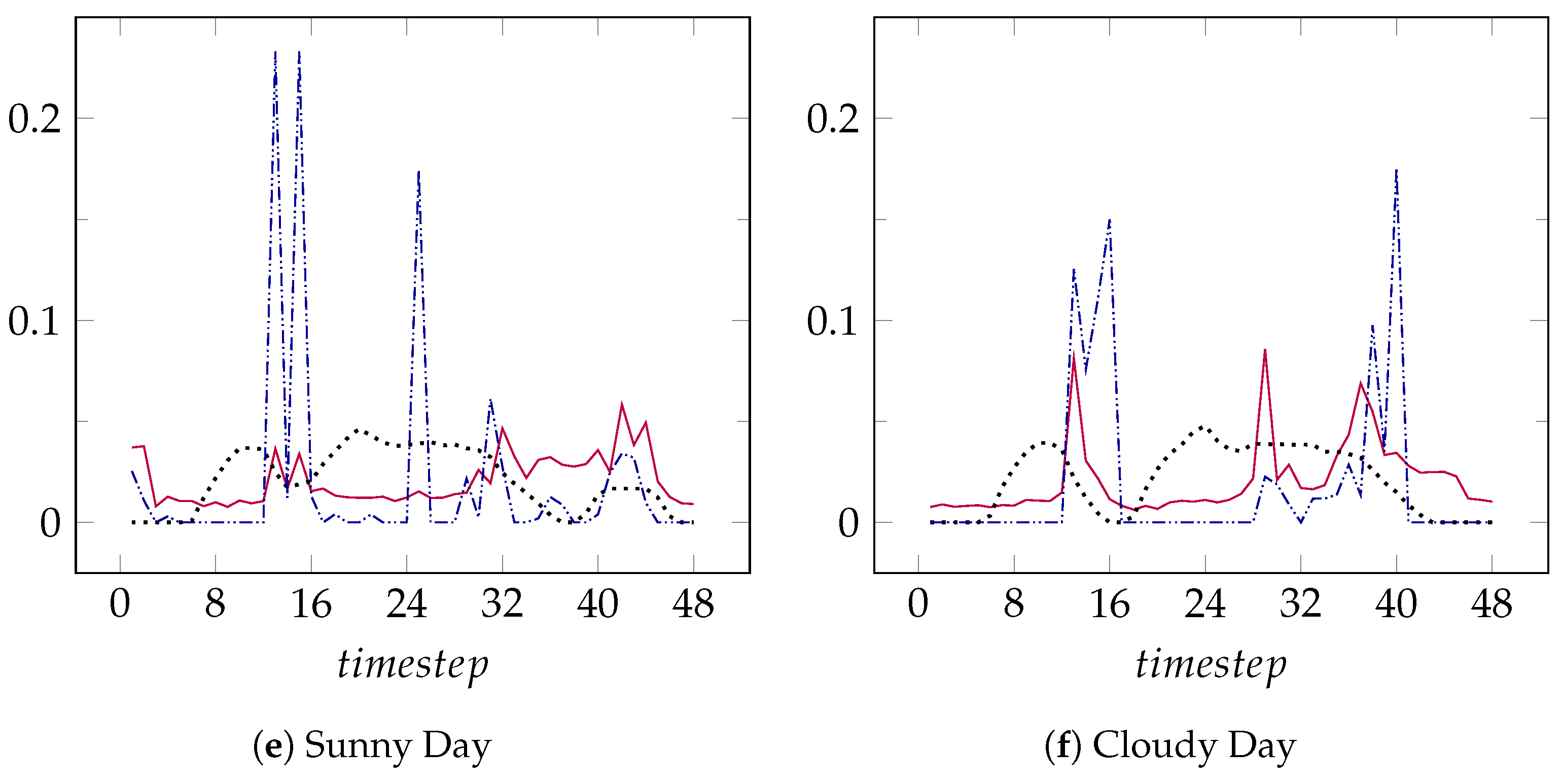
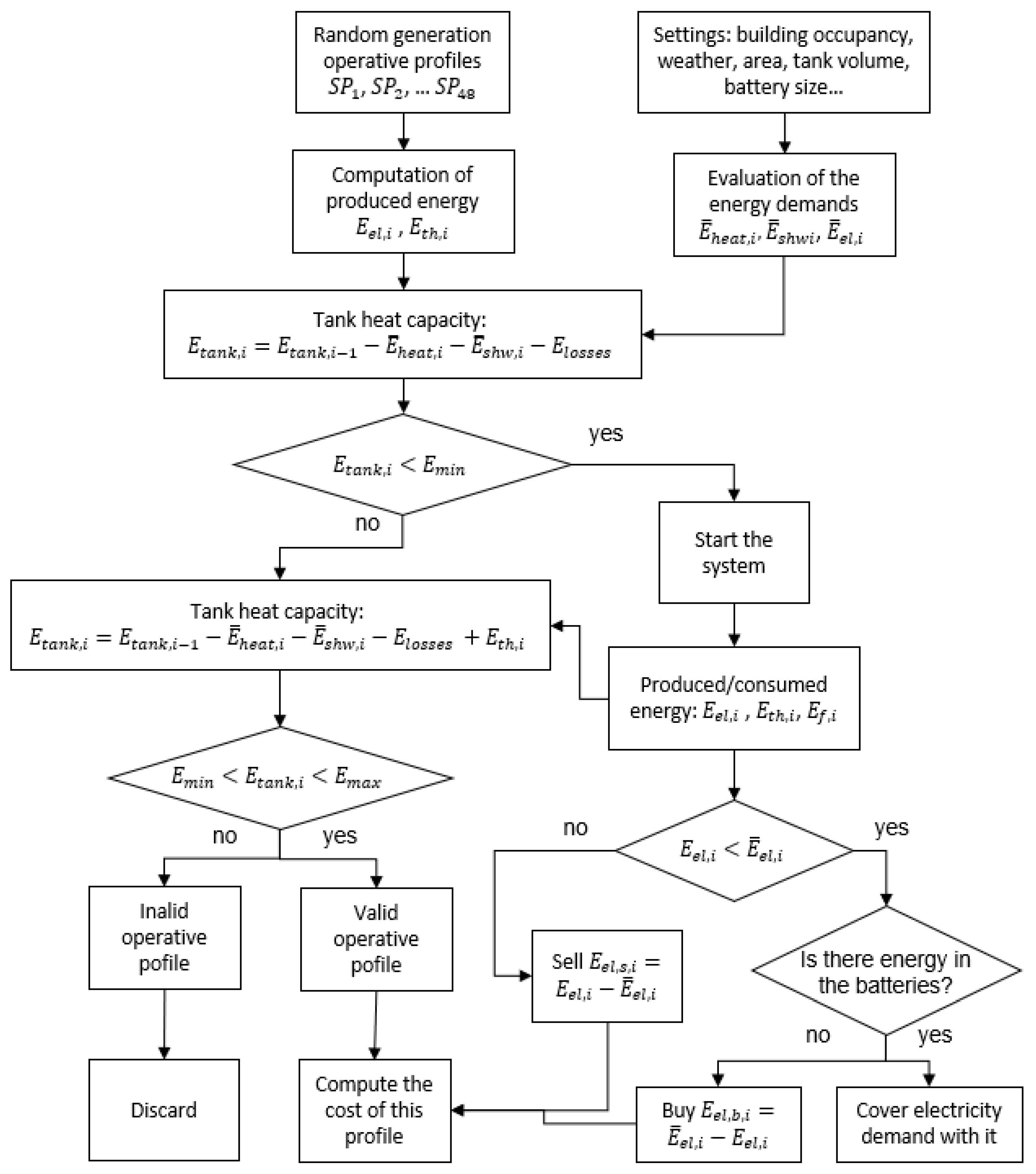
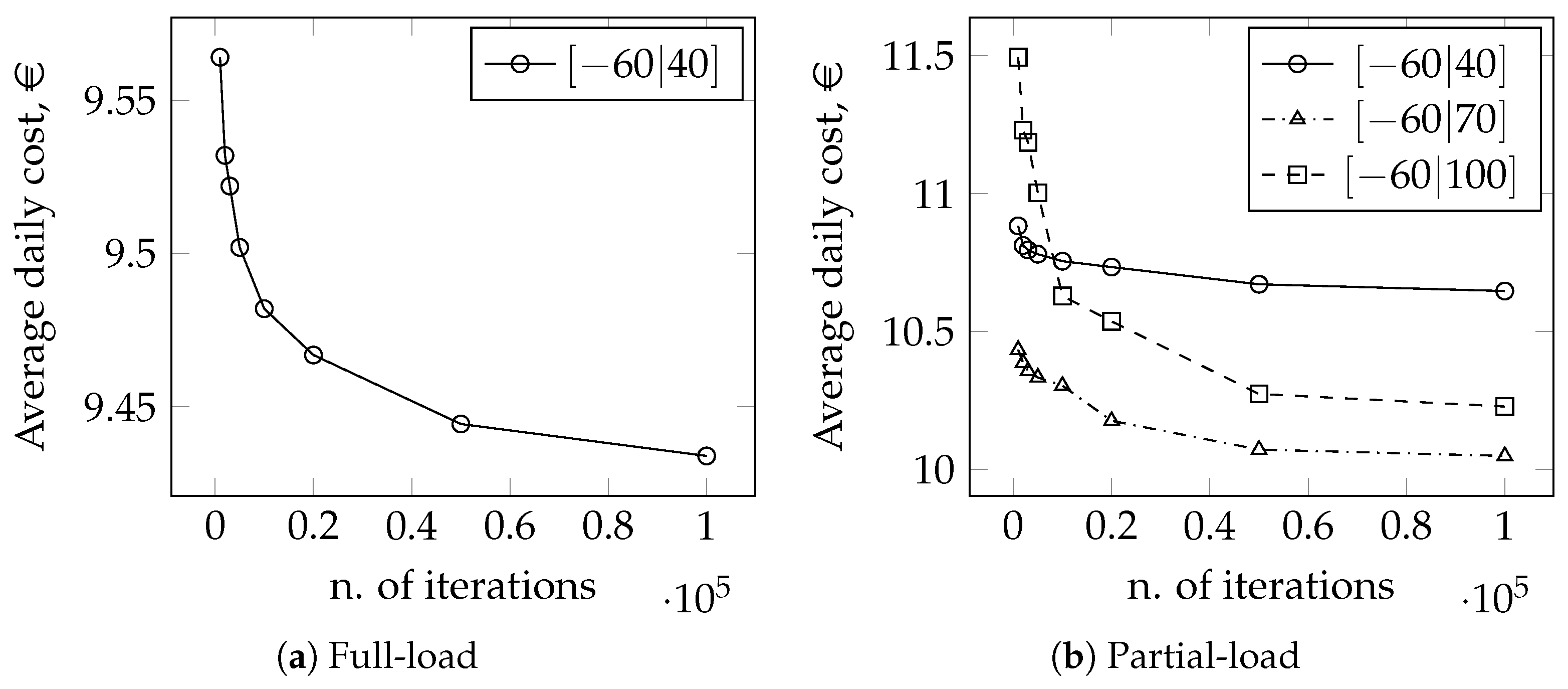


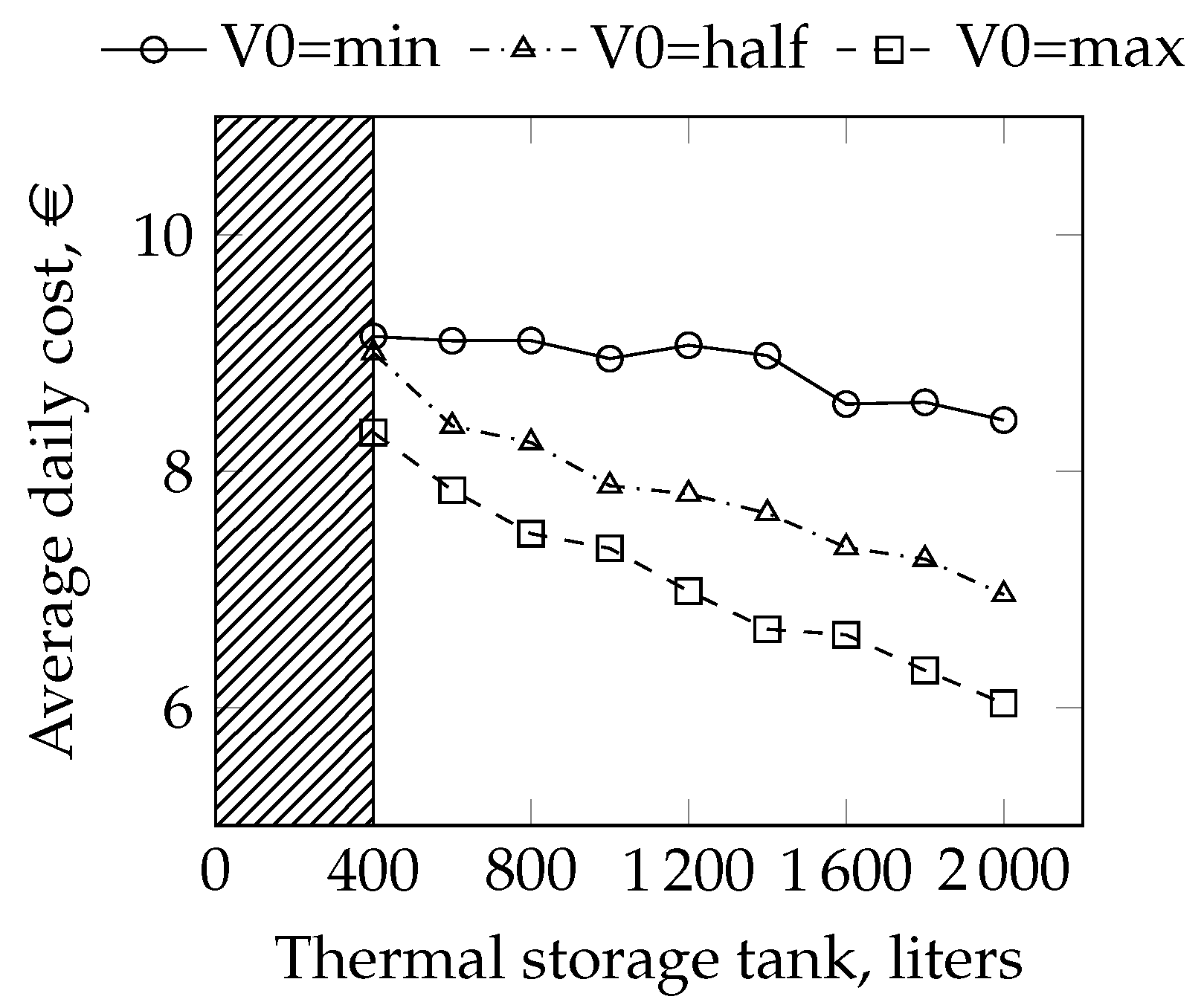
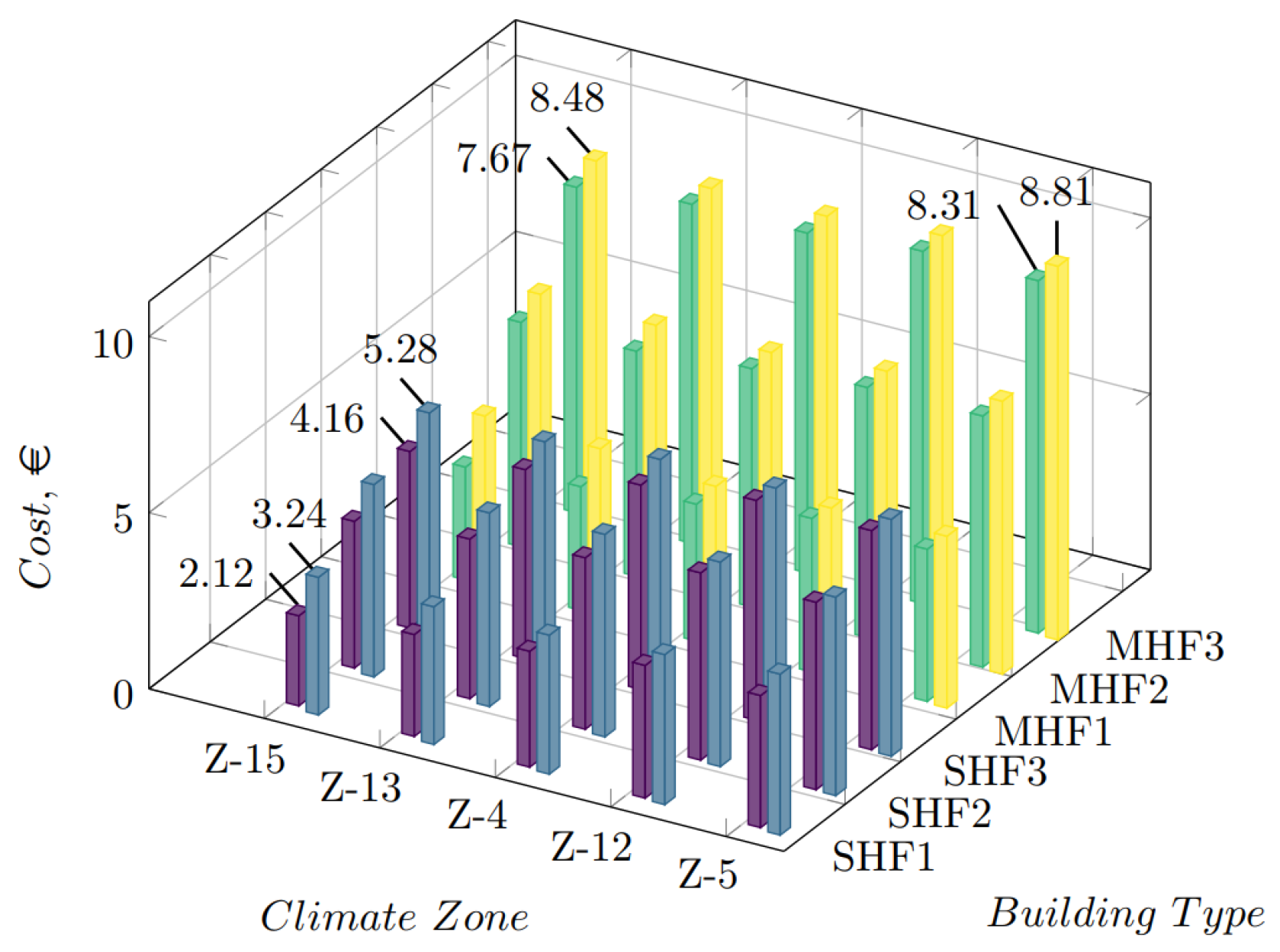

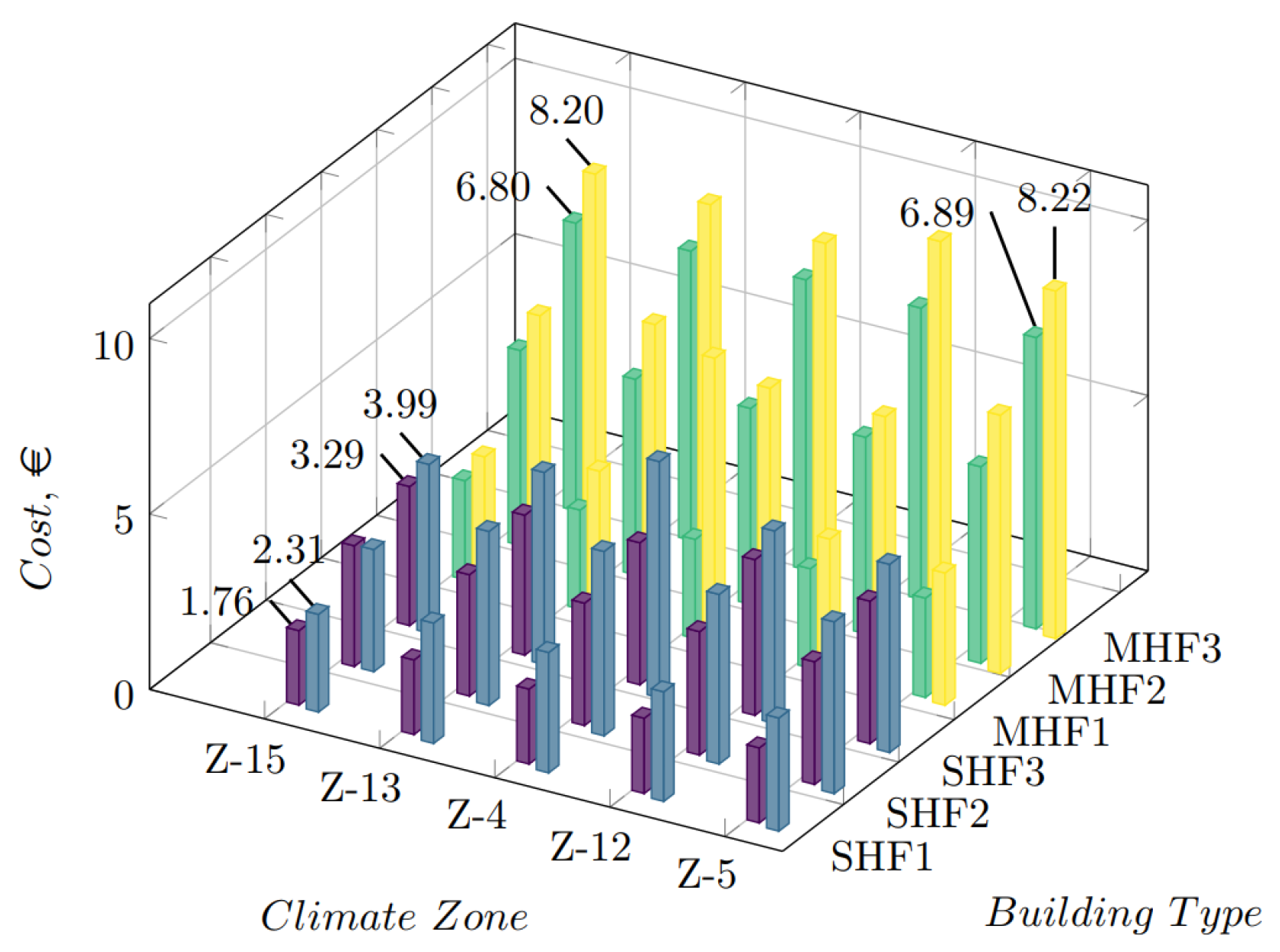
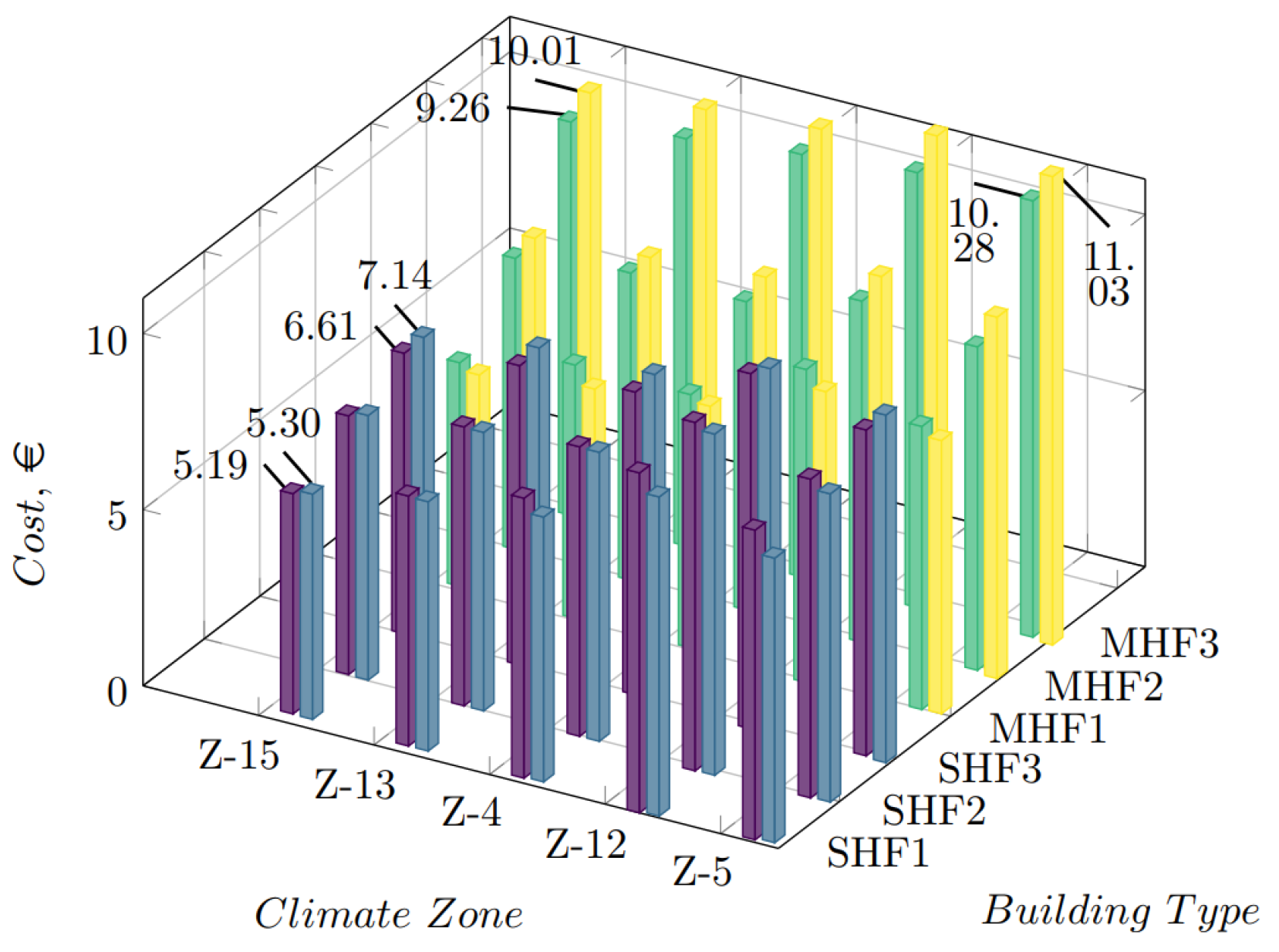
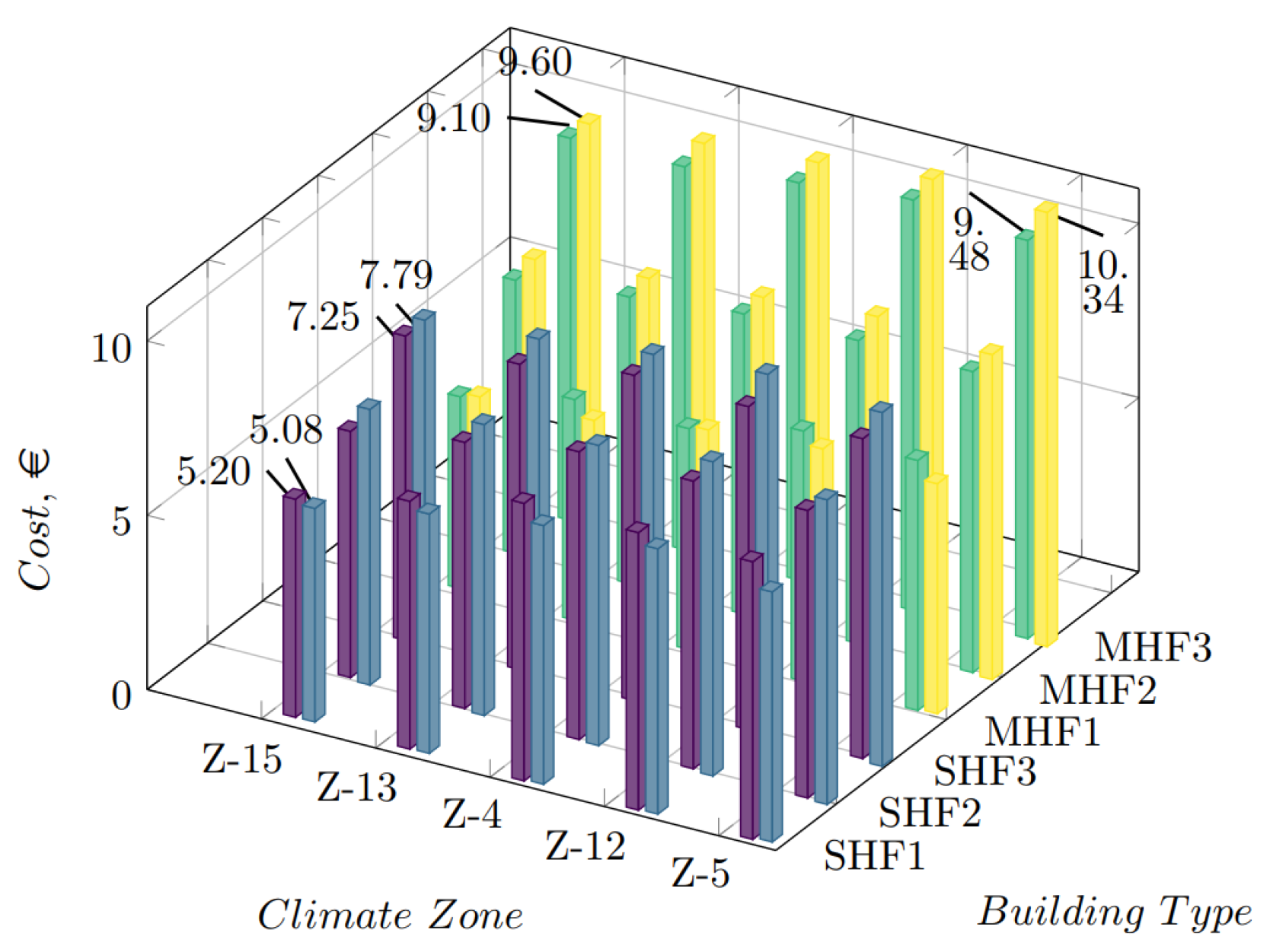
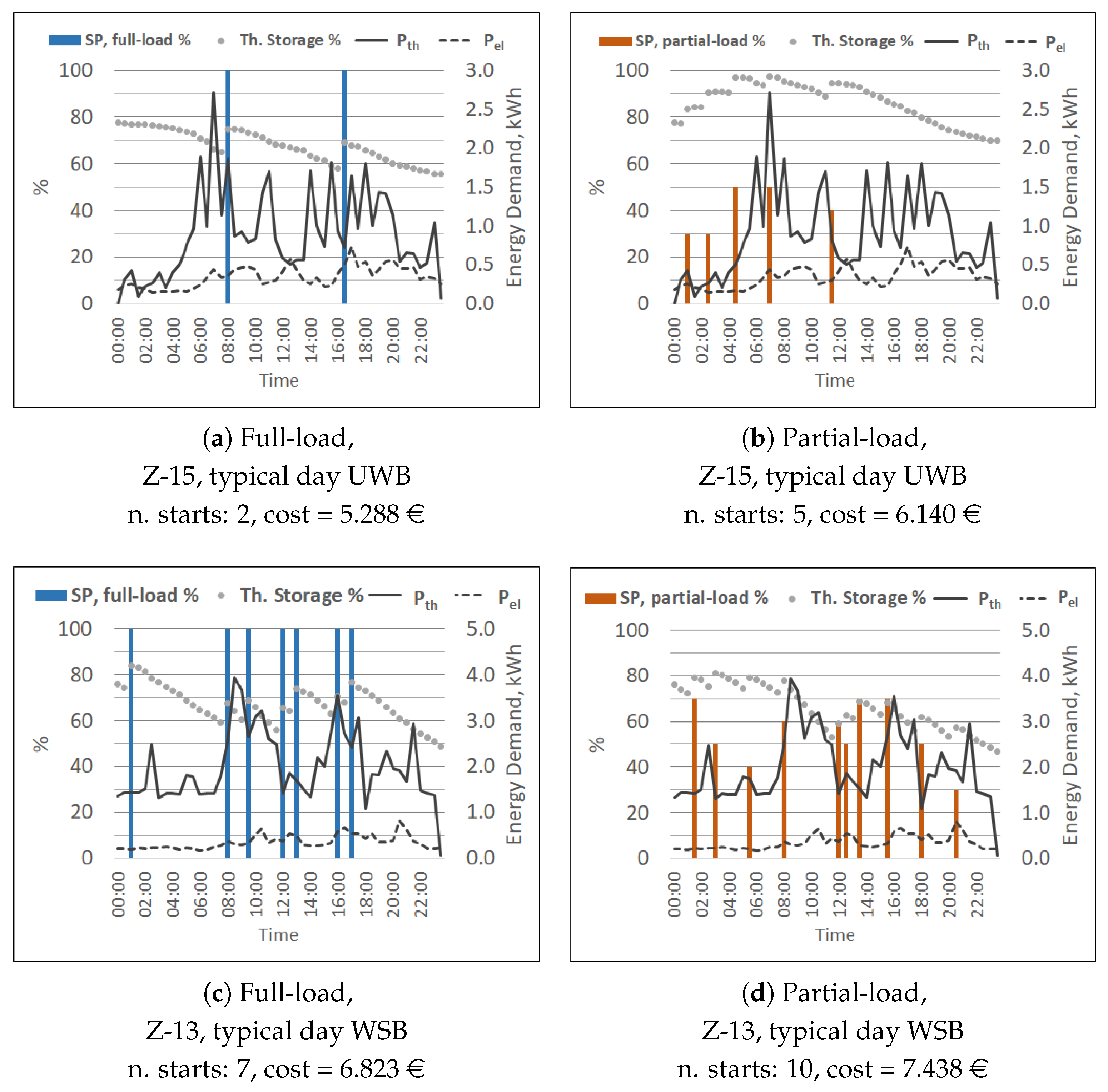
| SP | N (krpm) | (kW) | (kW) | (kW) |
|---|---|---|---|---|
| PC20 | 180 | 7.60 | 0.73 | 10.56 |
| PC40 | 190 | 8.40 | 1.02 | 11.96 |
| PC60 | 200 | 10.00 | 1.34 | 13.44 |
| PC70 | 210 | 11.30 | 1.69 | 15.46 |
| PC80 | 220 | 12.50 | 2.04 | 17.54 |
| PC90 | 230 | 14.20 | 2.39 | 19.77 |
| PC100 | 240 | 15.60 | 2.70 | 22.17 |
| Parameter | Sodium–Sulfur | Li-Ion | Lead Acid | Sodium Metal |
|---|---|---|---|---|
| Capital Cost-Energy Capacity (USD/kWh) | 661 | 271 | 260 | 700 |
| Power Conversion System (PCS) (USD/kW) | 350 | 288 | 350 | 350 |
| Balance of Plant (BOP) (USD/kW) | 100 | 100 | 100 | 100 |
| Construction and Commissioning (USD/kWh) | 133 | 101 | 176 | 115 |
| Total Project Cost (USD/kWh) | 907 | 469 | 549 | 928 |
Publisher’s Note: MDPI stays neutral with regard to jurisdictional claims in published maps and institutional affiliations. |
© 2022 by the authors. Licensee MDPI, Basel, Switzerland. This article is an open access article distributed under the terms and conditions of the Creative Commons Attribution (CC BY) license (https://creativecommons.org/licenses/by/4.0/).
Share and Cite
Cirigliano, D.; Grimm, F.; Kutne, P.; Aigner, M. Economic Analysis and Optimal Control Strategy of Micro Gas-Turbine with Batteries and Water Tank: German Case Study. Appl. Sci. 2022, 12, 6069. https://doi.org/10.3390/app12126069
Cirigliano D, Grimm F, Kutne P, Aigner M. Economic Analysis and Optimal Control Strategy of Micro Gas-Turbine with Batteries and Water Tank: German Case Study. Applied Sciences. 2022; 12(12):6069. https://doi.org/10.3390/app12126069
Chicago/Turabian StyleCirigliano, Daniele, Felix Grimm, Peter Kutne, and Manfred Aigner. 2022. "Economic Analysis and Optimal Control Strategy of Micro Gas-Turbine with Batteries and Water Tank: German Case Study" Applied Sciences 12, no. 12: 6069. https://doi.org/10.3390/app12126069
APA StyleCirigliano, D., Grimm, F., Kutne, P., & Aigner, M. (2022). Economic Analysis and Optimal Control Strategy of Micro Gas-Turbine with Batteries and Water Tank: German Case Study. Applied Sciences, 12(12), 6069. https://doi.org/10.3390/app12126069







